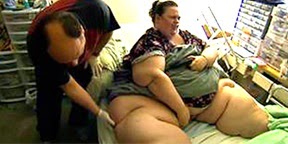Can Carpal Tunnel Syndrome Cause Fingers to Twitch?

A twitching finger makes a person fear they have ALS because this disease causes twitching, so they’re hoping that the real cause is carpal tunnel syndrome.
Finger twitching is common. It can come out of the blue for no apparent reason, however, making a person wonder if it’s the first sign of ALS. (more…)
Can Growth Hormone Injections Make a Short Child Tall ?

Will enough growth hormone injections cause a short child to grow enough to actually be tall for their age?
After all, why stop at just “not as short” when you can achieve “taller than average,” as some parents may wonder.
“The risk of long-term complications of growth hormone therapy in children has not been well-studied,” says Dr. Lisa Lewis, MD, a board certified pediatrician in Fort Worth, Texas, and author of “Feed the Baby Hummus, Pediatrician-Backed Secrets from Cultures Around the World.”
“For this reason, growth hormone treatments should only be reserved for children who are medically classified as short stature and deficient in growth hormone.
“If growth hormone is given to normal children with no growth hormone deficiency, the child is at risk of side effects from the treatment.
“Possible side effects of growth hormone given to a child who is not deficient in growth hormone include diabetes, high blood pressure, organ malfunction (heart, kidney, liver) and atherosclerosis.”
Healthy but Short Children’s Height Increase with HGH: Study
The “more is better” approach does not work when it comes to human growth hormone treatments for children of short stature.
A short child cannot be made tall with growth hormone treatments because the maximum height increase is about three inches.
This information comes from a study, published in 2007, led by Jackie Bryant, a researcher at the University of Southampton in England.
The study pertains to kids whose short height has no medical or other known cause; they are otherwise healthy.
For the study, 10 randomized controlled trials were analyzed, involving 741 kids who were very short but otherwise healthy.
Despite the multitude of injections required, the kids’ ultimately ended up still short, near the lower range of normal, relative to their same-age/gender peers.
According to the report, a final height increase of three inches may cost between $108,000 and $216,000.
One of the reviewed studies included a psychological comparison between the kids who were treated with GH and the control group.
The kids who were treated with growth hormone had reported no improvement in their quality of life.
It’s fair to wonder if they’d report a jump in quality if the height increase actually made them taller than average, vs. merely just not as short.
Growth Hormone for Kids with GH Deficiency: When Is It Too Late for Treatment to Be Effective?
Dr. Lewis explains, “It is too late for treatments to be effective when an adolescent has stopped growing.
“The growth plates in the bone are fused at this point, and no further growth can occur.”
Having 25+ years’ experience, Dr. Lewis completed her pediatrics residency at Texas A&M University Health Science Center, Scott and White Memorial Hospital. For two years afterward she was assistant professor in the department of pediatrics at Texas A&M University Health Science Center.
 Lorra Garrick has been covering medical, fitness and cybersecurity topics for many years, having written thousands of articles for print magazines and websites, including as a ghostwriter. She’s also a former ACE-certified personal trainer.
Lorra Garrick has been covering medical, fitness and cybersecurity topics for many years, having written thousands of articles for print magazines and websites, including as a ghostwriter. She’s also a former ACE-certified personal trainer.
.
Top image: Shutterstock/aekkorn
Source: cochranelibrary.com/cdsr/doi/10.1002/14651858.CD004440/abstract
Can Elderly with Broken Hip Recover without Physical Therapy?

What if an elderly person refuses to do the prescribed physical therapy following replacement for a hip fracture?
Are they doomed to spending the rest of their life hobbling along in a walker or sitting in a scooter? (more…)
Why Pain in Both Legs Can Mean Heart Attack within Five Years

Pain in both legs that won’t respond to standard treatments or exercise may be a sign of a pending heart attack or one a few years later.
It’s quite simple to understand: The process that causes arteries to clog up in the heart can also cause arteries in the legs to clog up. (more…)
How to Tell when a Cancer Patient Is About to Die

There are ways you can tell when a cancer patient in the latest stages of disease is about to die.
These signs are an alert that death is very imminent.
“Cancer patients who are at the end of their life tend to be tired and weak, resulting in an increased requirement for sleep,” says Jonathan Stegall, MD, an integrative oncologist and medical director for The Center for Advanced Medicine, an adult cancer treatment center in Alpharetta, GA.
“They often lose the desire for food and drink, and frequently stop seeking interaction with others,” continues Dr. Stegall.
The aversion to eating even a small portion of their favorite foods is because their body, all its systems, is shutting down – and therefore has no need for any sustenance.
There will also be a reduced response to verbal stimuli.
In addition, according to a study (Hui et al), there is a reduced response to visual stimuli.
There may be a drooping of the so-called smile lines, along with grunting, hyperextension of the neck with the head tilting off the bed, eyes that do not close and pupils that do not react to changes in lighting.
These latter signs are not a 100 percent guarantee of imminent death (within three days), but the study says that very few patients who had these signs were alive more than three days later.
The study authors point out that due to the small number of subjects in this research, the results cannot be generalized to apply to illnesses other than cancer, nor to terminal cancer patients in all possible settings such as the patient’s home.
General Signs that Death Is Near for a Cancer Patient

Shutterstock/CandyBox Images
“Depending on the cancer type, pain levels can increase, resulting in a need for additional pain medication,” says Dr. Stegall.
“Breathing changes can also occur, ranging from more rapid breathing to some periods of apnea [paused breathing].
“Dying patients will sometimes become anxious, agitated and restless.
“They might see or hear things that aren’t there [or at least perceivable to family members], including loved-ones who previously died.
“Finally, patients who are close to death might lapse into a coma, where they are completely unresponsive.
“Although they are not responsive, it is believed that they continue to hear and perceive things around them.”
When a cancer patient is close to death, about to die, the process is actually pretty similar to that from other illnesses such as kidney failure, heart failure, systemic infection and COVID-19.
Whether caused by cancer or other conditions, the body shuts down pretty much the same across the board.
This is why the narrative of the dying process, that’s provided by hospice care services, is in template or general form rather than specific to a particular medical condition.
When cancer patients in movies and TV shows are shown dying (in bed), they’re typically talking and making good eye contact to a loved-one.
Then suddenly they cease talking and close their eyes, and for dramatic effect, the director has them move their head slightly away from the family member at the bedside.
In the end stage of a chronic, progressive disease (whether cancer or another illness), it certainly can happen that someone weakly speaks, then passes.
But in general, there’s a phase between their last spoken words, last open eyes – and when they take their last breath.
In acute injuries such as a stabbing or gunshot wound, a person can be talking quite a bit and then abruptly lose consciousness and die.
 Jonathan Stegall, MD, provides a long-awaited remedy for our cancer problem. Having a successful integrative oncology practice in Atlanta, GA, he’s seen firsthand what works and what doesn’t with cancer treatment. Dr. Stegall is the creator of the Cancer Secrets Podcast and author of “Cancer Secrets,” available on Amazon.
Jonathan Stegall, MD, provides a long-awaited remedy for our cancer problem. Having a successful integrative oncology practice in Atlanta, GA, he’s seen firsthand what works and what doesn’t with cancer treatment. Dr. Stegall is the creator of the Cancer Secrets Podcast and author of “Cancer Secrets,” available on Amazon.
 Lorra Garrick has been covering medical, fitness and cybersecurity topics for many years, having written thousands of articles for print magazines and websites, including as a ghostwriter. She’s also a former ACE-certified personal trainer.
Lorra Garrick has been covering medical, fitness and cybersecurity topics for many years, having written thousands of articles for print magazines and websites, including as a ghostwriter. She’s also a former ACE-certified personal trainer.
Source: acsjournals.onlinelibrary.wiley.com/doi/10.1002/cncr.29602
Appearance of Pencil Stools of Colon Cancer Compared to IBS

Colon cancer can cause pencil shaped stools. So can irritable bowel syndrome.
And therein lies the problem when you see skinny poops coming out of you that resemble a pencil shape or how toothpaste looks like coming out of the tube.
Let’s take a closer look at how pencil shaped stools from irritable bowel syndrome might appear different from flattened narrow bowel movements caused by colon cancer.
“The occasional narrow stool is not of major concern,” begins Santosh Sanagapalli, MD, a consultant gastroenterologist, endoscopist and colonoscopist.
“However, a persistent narrowed stool, for example — of pencil thickness — can sometimes occur due to narrowing or obstruction of the colon from a colon cancer.
“The problem is that changes in the stool form or shape can also be a common feature of irritable bowel syndrome.”
This is caused by colon contractions or spasms.
In this case the muscles in the colon contract involuntarily. These spasms can cause changes in bowel movements.
Dietary factors, such as intolerance to certain foods or eating high-fat meals, can worsen colon contractions.
Emotional stress and anxiety are also significant contributors, as the gut-brain connection can influence bowel motility and trigger spasms.
Appearance of Skinny Bowel Movements from Colon Cancer vs. Irritable Bowel Syndrome
Dr. Sanagapalli explains, “Based on the appearance of the stool alone, one cannot differentiate between a benign cause such as IBS and a concerning cause such as bowel cancer.”
The stools from either condition will look the same as they are voided and also as they end up in the toilet bowl.
“Further, IBS is a far more common condition than colorectal cancer,” continues Dr. Sanagapalli.
What should you do?
“The decision to investigate further is based on any concurrent symptoms and the patient demographic,” says Dr. Sanagapalli.
“For example, in a young woman who describes changed (narrowed) appearance of the stool but no bleeding, weight loss, anemia or abnormal findings on examination, then the diagnosis is likely to be IBS.
“However, in an older male who describes such a change in his stool appearance, along with rectal bleeding or other concerning features such as anemia or weight loss, there would be much higher concern for colorectal cancer.
“The symptom therefore requires careful evaluation by a gastroenterologist (both history, physical examination and blood tests) to decide on the likely diagnosis and need for further investigation.”
Procedures such as colonoscopy can help visualize the colon and identify any structural or inflammatory issues, while imaging tests like CT scans or X-rays may be used to rule out other conditions.
Further investigation would likely mean a colonoscopy.
- Blood in the stools (red or dark)
- Old blood in the stools (like tar)
- Pencil-thin or ribbon stools
- Feeling of incomplete voiding
- Constipation or diarrhea
- Alternating constipation/diarrhea
- Odd change in bowel habits
- Abdominal pain or cramps, gas
- Feeling of bloating or fullness
- Unexplained weight loss
- Unexplained appetite suppression
- Unexplained fatigue
 Dr. Sanagapalli is a gastroenterologist and director of the Esophageal Disorders Center at St Vincent’s Hospital, Darlinghurst. He performs diagnostic and therapeutic endoscopic procedures, and enjoys providing comprehensive and holistic care to patients with a wide variety of disorders affecting the gastrointestinal tract.
Dr. Sanagapalli is a gastroenterologist and director of the Esophageal Disorders Center at St Vincent’s Hospital, Darlinghurst. He performs diagnostic and therapeutic endoscopic procedures, and enjoys providing comprehensive and holistic care to patients with a wide variety of disorders affecting the gastrointestinal tract.
 Lorra Garrick has been covering medical, fitness and cybersecurity topics for many years, having written thousands of articles for print magazines and websites, including as a ghostwriter. She’s also a former ACE-certified personal trainer.
Lorra Garrick has been covering medical, fitness and cybersecurity topics for many years, having written thousands of articles for print magazines and websites, including as a ghostwriter. She’s also a former ACE-certified personal trainer.
Dr. Now Scolds James K’s Enabler on “600 Pound Life”

James as a young adult
“This is mind boggling why you keep overfeeding him!” Dr. Now scolds an enabler on “My 600 Pound Life.” Finally, Dr. Now lashes out at an enabler!
The Lisa and James situation aired for the first time on March 15, 2017.
Many “600 Pound Life” viewers seethe flames at the enablers, but Lisa has got to be one of the worst enablers I’ve ever seen on this show.
I thought Penny Saeger’s enabling husband was the worst, but Lisa takes the cake (no pun intended).
The subject is James, 46 (as of 2017), who’s confined to his bed and has grotesque pebble-like protrusions, lesions and other yucky stuff on his legs from cellulitis that is prone to draining.
I don’t mean to be cruel, but in all sincerity, James’ lower body looks like Jabba the Hutt’s.
Lisa doesn’t seem to mind wiping up the oozing every day nor having pulled their teen daughter out of school to help care for her father.
Because James is paralyzed by his weight, he is 100 percent dependent on Lisa for food intake, and she is shown bringing him plate after plate loaded with high calorie food.
About an hour into the two hour episode, Dr. Now really lays into her after James not only fails to lose the recommended amount of weight to qualify for the surgery, but he gains some.
• Dr. Now’s voice is deeper and more snarling.
• He’s not the softie he usually is.
• He corners Lisa by asking what would happen if she just stopped bringing him all the food.
• She replies, “I will have hell to pay for the rest of the day.”
• Dr. Now fires back something like, “What’s he gonna do to you while he lies in bed? Scream and yell? So let him scream and yell!”
Later on in the show, James is given yet another chance by Dr. Nowzaradan, and when he comes back for his next weigh-in, he’s UP by 158 pounds – after Lisa insisted that she kept James on the prescribed diet.
That’s when Dr. Now chastises Lisa: “This is mind boggling that you keep overfeeding him.”
And he’s so right: It is mind boggling how these enablers operate. Even after James suffered acute heart failure, that wasn’t enough for Lisa to stop bringing him platefuls of food. Every time he went back for a weigh-in, he had gained.
So Lisa, as well as other enablers, believe they will have hell to pay for the rest of the day should they refrain from overfeeding their 600-pound-plus significant others, grown kids or parents.
What is this “hell” when compared to the hell of playing a key role in CAUSING THEIR DEATH?
Are these enablers so thin skinned that they can’t ignore a temper tantrum that’s being thrown from the confines of a BED?
It was very refreshing to finally see Dr. Nowzaradan scold an enabler. He needs to go into scolding mold more often, even if it doesn’t snap the enabler out of their delusion.
But I’m betting that more times than not, it would. It’s just that in the James and Lisa case, it didn’t.
After 11 months, James and Lisa were finally turned away by Dr. Now, though the doctor had supported the idea of having two physical therapists drop by and help James sit up for the first time in a few years.
At the end James announced that he was determined to get under 600 pounds and get the surgery, but the only way this will ever happen is if Lisa stops being his enabler.
“My 600 Pound Life” takes the viewers back in time to the childhood of every subject, so that we can see what could have triggered the descent into 600 pound madness.
I’d like to see some of the footage that’s spent on boring travel preparation scenes be replaced by even just five minutes of exploring the childhood of the enabler.
Lisa is slowly killing her daughter’s father and enlisting in her help to do so. Sure, James could always say “No” to all the eating, but he can’t get any food without his enabler’s help.
 Lorra Garrick is a former personal trainer certified by the American Council on Exercise. At Bally Total Fitness she trained clients of all ages for fat loss, muscle building, fitness and improved health.
Lorra Garrick is a former personal trainer certified by the American Council on Exercise. At Bally Total Fitness she trained clients of all ages for fat loss, muscle building, fitness and improved health.
How to Beat Menopausal Blues by Lifting Heavy Weights

The depression of menopause can swoop in like a vulture, but you can fight back by learning to lift heavy things!
Chase away the menopause blues by training your body to lift and carry heavy weights. (more…)
How to Do Seated Hamstring Curls to Burn the Most Fat

There is a way to do seated hamstring curls to burn the most fat.
Seated hamstring curls may seem simple enough, but there are specific things you can do to maximize your fat burning results.
With seated hamstring curls, make sure your feet are always held in a 90 degree angle. Do not let them relax, as shown below.
From the moment you begin pushing down on the pad, all the way throughout pushing the pad to the down position (fully flexed knees), the feet stay in a 90 degree angle.

When pressing pad down, flex knees (bend legs) as far in as possible, all the way, till you feel pad making contact with machine.
Few people do this, and instead, do seated hamstring curls only 80 or 90 percent of the way.
Depending on the make and model of the seated hamstring curl machine, the maximum knee flexion angle won’t be that much less than 90 degrees.
Other seated hamstring curl machines can be adjusted to permit quite a bit of knee flexion. At any rate, bend your legs as much as the machine will allow.
Next, hold this maximal bent position for three seconds before releasing.
In order to do this for 8-12 repetitions, you will need a lighter weight, rather than the weight you normally use. I don’t recommend this three second hold for every set, but for two or three of them.
Make sure it’s a true solid three second hold, maintaining contact between pad and machine.
When releasing the pad for seated hamstring curls, don’t let it fly up. Release with control, and bring it back down before it goes up all the way.
Legs may be as far apart as possible, closer together, or completely together for any given set.
I recommend taking all positions throughout your seated hamstring curl routine for best fat burning.
Furthermore, feet should be turned outward as much as possible, legs apart as far as possible, for at least two sets. Try this tweaking; you’ll feel the difference and will burn more fat.
For seated hamstring curls, you can lean back in the seat, or lean forward. Always make sure the support pad is secure atop your thighs. Hands can be anywhere.
Start out with a few lighter sets with the three second hold, then use heavier weight with each set (the three second hold won’t be possible at heavier weights).
Get in at least three super heavy sets in which you can move the weight only 7-10 times max — all the way back, making the pad touch the machine every time.
Make these adjustments with your hamstring curl routine for best fat burning results, and the backs of your legs will become significantly stronger and tighter.
 Lorra Garrick is a former personal trainer certified through the American Council on Exercise. At Bally Total Fitness she trained women and men of all ages for fat loss, muscle building, fitness and improved health.
Lorra Garrick is a former personal trainer certified through the American Council on Exercise. At Bally Total Fitness she trained women and men of all ages for fat loss, muscle building, fitness and improved health.
.
Top image: Shutterstock/ESB Professional
Hamstring Curls Lying Down: Proper Techniques for Best Results






































































